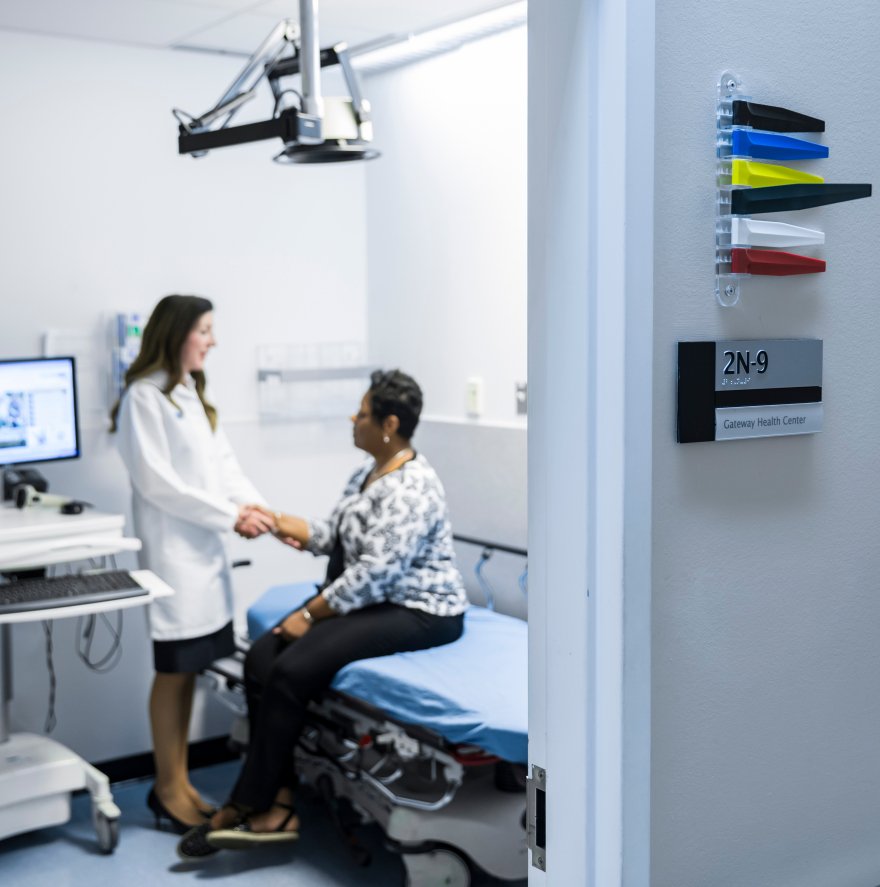DETROIT, MI | By JAY GREENE | June 25, 2017
Original article can be found at: http://www.crainsdetroit.com/
An innovative program to reduce costs, improve care continuity and connect high users of emergency departments at four Detroit Medical Center hospitals with a primary care team has led to significant reductions in unnecessary ER visits, hospitalizations and readmissions, said a top DMC physician executive.
DMC’s Gateway to Health program — funded by a three-year, $10 million grant through the Patient Protection and Affordable Care Act of 2010 — has enrolled more than 6,500 people and enabled those patients to visit DMC Gateway outpatient clinics a total of 16,000 times over nearly three years, said Suzanne White, M.D., DMC’s chief medical officer.
While financial savings and complete patient outcome data isn’t expected until later this year, White said the federal government is happy enough with the initial results of DMC’s Gateway program to extend the funding to a fourth year.
Any reduction in unnecessary emergency room visits is good news for hospitals and health care costs. They have been an intractable problem that comes with high costs and a high level of uncompensated care for hospitals.
“We are very proud of what the Gateway team has done,” said White, an emergency medicine physician and principal investigator of the study. “Patients have improved outcomes and we have a 95 percent satisfaction rate.”
Using DMC’s electronic medical record system, ER staff have identified the patients who either have one of seven chronic conditions or are frequent flyers in the ER — five or more visits per year, White said.
“Our multidisciplinary teams are providing expanded services with behavioral health, social work, pharmacy and dietary,” White said.
When patients seek ER care for non-life threatening conditions, ER staff explains the Gateway program and recommends they enroll. DMC offers Gateway outpatient clinics adjacent to the hospital ERs with hours that range from 8 a.m. to 11 p.m. About 75 percent of enrolled patients schedule direct appointments with the Gateway clinic.
“Patients who enroll are sticking with the program, which is what we hoped to see,” she said. “These are very high-cost patients. We assess their physical and mental health. Their own self-assessments shows they are lower than baseline for health.”
White said ER visits, hospitalizations and readmissions have gone down significantly for the patients enrolled in the program. “We found up to 70 percent reductions (in ER visits) for the super utilizers” (more than five per year), she said.
Frequent ER users
Several metro Detroit hospitals try to identify high ER users and expand primary care access for those patients when they can. Some hospitals like DMC and Henry Ford Hospital in Detroit have added same-day clinics for primary care services. They use social workers for patient education and work closely with mental health providers for outpatient care.
Hospitals affiliated with Ann Arbor-based St. Joseph Mercy Health System use a program called Complex Care that helps identify high-risk users of hospital services, including emergency departments. The goal is to minimize unnecessary use of services and improve patient safety.
Others like St. John Hospital in Detroit and Providence Hospital in Southfield refer ER patients without primary care doctors to their physician referral lines. Most all try to sign up the uninsured to Medicaid or direct patients to free outpatient clinics or federally qualified health centers for followup care.
But White said many of these programs that refer patients to outside providers don’t address the root cause of inappropriate ER use.
“Historically that model (of referral) has not worked. If you have the patient in front of you, you have an opportunity for patients to have teachable moments in the ER,” White said. “When you refer them to a clinic a block away, typically that model fails with that patient because it requires a lot of navigation up front.”
Data from a recent report of Michigan hospital ERs showed that 10 percent of the uninsured use the hospital emergency department for routine primary care, compared with 3 percent for those with insurance, said Ann Arbor-based Center for Healthcare Research and Transformation.
Nationally, total ER visits have remained somewhat stable at about 410 per 1,000 people, or about 130 million per year, the past decade. Michigan annually has about 5 million hospital ER patient visits.
While reducing unnecessary ER use was one of the goals of the Affordable Care Act, a 2016 report by the Centers for Disease Control and Prevention said little improvement was made in the study years of 2013 and 2014. Some 77 percent of adults under age 65 said they used the ER because they believed their medical problem was serious. Another 12 percent of adults said they used the ER because their physician’s office was closed when they needed treatment.
Still, hospital ER officials say one solvable problem is to reduce the number of people who use the ER five to 10 to 20 or more times each year. These high ER users with multiple chronic conditions are what many experts are trying to address with programs like Gateway and the Community Resources for Emergency Department Overuse, or CREDO.
Henry Ford ER use
Over the past decade, Henry Ford Hospital has used the CREDO program to identify high users of emergency services and either offer them additional services or track their use to reduce misuse of tests or procedures.
About 275 people are enrolled in Henry Ford’s CREDO program at any one time, said Stephanie Stokes-Buzzelli, M.D., a Henry Ford emergency physician. Patients are chosen for CREDO by a multi-disciplinary committee of nurses, doctors, psychologists, social workers and administrators.
“We create a CREDO brief, a synyopsis of their medical problems,” Stokes-Buzzelli said. “They are guidelines that summarize” the medical record of each patient.
When a patient enrolled in CREDO presents in a Henry Ford ER, Stokes-Buzzelli said, he or she is evaluated and treated like any other patient for an emergency condition. But CREDO patients are flagged for extra attention.
“An alert appears (on their electronic chart). If there is alignment with a previous complaint, we treat them, but maybe we don’t do another MRI” if they had one recently enough, Stokes-Buzzelli said. “Some patients require extra social services, a primary care visit or a meeting with a community mental health partner” such as Central City Integrated Health or New Center Community Services.
The ultimate goal, said Stokes-Buzzelli, is to “channel them back to a primary care provider, avoid duplication of services because ER care is so fragmented.”
Results of Gateway
Under Gateway, patients who don’t have primary care physicians and have multiple chronic conditions are identified and offered coordinated care services. The four participating DMC hospitals are DMC Harper University Hospital, DMC Detroit Receiving Hospital, DMC Sinai-Grace Hospital and DMC Children’s Hospital of Michigan.
Patients have a variety of conditions, including diabetes, asthma, hypertension, heart failure, chronic lung disease, depression and HIV. About 51 percent have Medicaid coverage, 25 percent are uninsured, 14 percent have Medicare and 10 percent have commercial insurance, White said.
Here is some preliminary data from the Gateway to Health program during January 2015 to May 2017:
- 6,500 enrolled patients had 16,000 total outpatient visits. The visits include access to a multi-disciplinary primary care team. Patient satisfaction scores averaged 95 percent approval.
- Of the 112 diabetic patients who came in for more than one visit, 78 experienced improved HbA1c (blood sugar levels), or 70 percent, compared with their initial visit. More than 285 total diabetic patient have been seen at least once.
- Of 232 patients with high blood pressure who came in for multiple visits, 118 showed improved cholesterol levels, or 51 percent, compared with their initial visit. Some 771 total patients have been seen at least once for hypertension.
- Data shows the number of multiple emergency department visits by Gateway enrolled patients decreased by about 70 percent. Some 2,075 patients showed a decrease in ER use after their first Gateway appointment. Another 1,153 patients have had zero ER visits since their initial visit.
White said diabetes and hypertension were chosen for closer reviews because those patients visited hospital ERs more frequently.
Federal funding for the Gateway grant was provided by various taxes collected under Obamacare and are part of the act’s quality-improvement and cost-reduction provisions. DMC’s grant is funded through Sept. 1, 2018.
After federal funding ends, White said she hopes to work with federal and private payers to continue the program well into the future by developing payment codes for various primary care services rendered in the ER.
“We are hoping to sustain the program by working with payers to develop reimbursement models,” White said. “This is an innovative model, the first step in the direction for direct access to primary care.”
DMC covered about 85 percent of the costs of the program from the $10 million federal grant. Additional funding came from insurance coverage with the rest was funded by DMC, White said.
Share this Post













